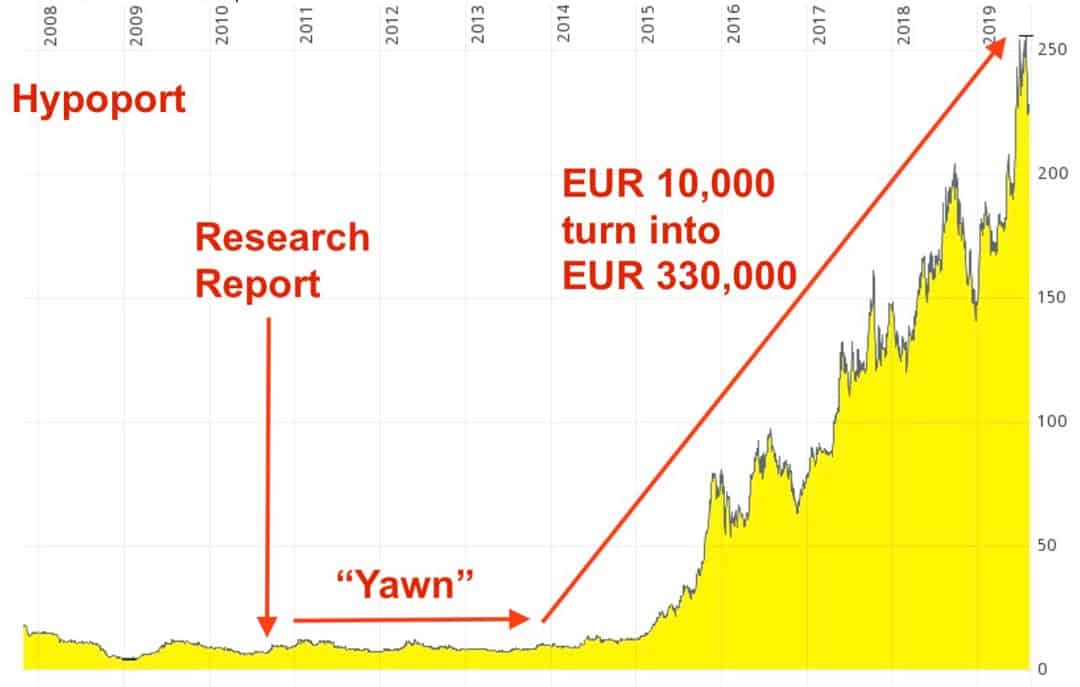Some of you will remember that I used to operate this website from 1998 to 2010, before taking an eight-year hiatus from publishing investment ideas.
The last report of the "old era" is worthwhile looking at again, because it teaches us a few timeless lessons in equity investing.
In September 2010, I published an extensive report about Hypoport (ISIN DE0005493365). At the time, the company was an unknown minnow with a EUR 46m market capitalisation. After releasing the Hypoport report, my life became too busy with other projects, and I eventually switched off the site (until relaunching it on 28 December 2018).
Hypoport is currently worth EUR 1.5bn, up about 32 times.
Looking back at the original report – which German-speaking readers are welcome to download from my archive – there are a few timeless lessons to be learned.

The kind of stock price graph I love looking at again
What it was all about back then
Hypoport operates a software platform that enables banks and other financial services providers to buy and sell financial services from each other and at much lower costs. Historically, it has been particularly active in the mortgage sector.
My 16-page report on Hypoport was based on three fundamental theses:
- The company's software platform was going to become a standard product used by financial services not just in Germany, but across Europe. I described it as "the future SAP of the mortgage platform software industry".
- Because of its strong market position in the German mortgage sector, it was going to benefit disproportionately from a buoyant German housing market.
- Key valuation figures, e.g., a price/earnings ratio of just 7, indicated the company was way too cheap, given its growth prospects.
All of this turned out to have been spot on.
There was a catch, though.
As with almost everything in life, there is always a final hurdle that needs to be overcome. Often, these turn out to be more challenging than expected. Though, once you have overcome them, the payoff is also often much larger than you expected.
The market took its time before it woke up
In retrospective, it all seems like an entirely clear case. My website spotted a great opportunity, readers piled in, and then it made a fortune for everyone who stuck around.
Right?
The problem was, Hypoport needed three long years to get into gear. By September 2013, the stock had barely moved up by 10%. Hypoport stocks seemed as dull an investment as they come.
It was only in 2014 that the stock started to move noticeably higher, and in 2015 the investment case finally unleashed its full force.
I do know some people who stuck around for the most significant part of what was to come. But I also know others who threw in the towel early and who have been kicking themselves ever since.
What's to be learned from all this, and how can you avoid missing such multibaggers?
You don't need to repeat the mistakes that others already made for you
I put a lot of thought into the entire concept of relaunching Undervalued-Shares.com.
- How could I make the website to be of maximum use to a private investor?
- What lessons had I learned from all my past publishing of research?
- How had the world around us changed?
The success of the Hypoport investment was one of the key reasons why I decided to relaunch the website in the first place. (The other one was my recommendation in late 2015 – published on social media – to pile into Bitcoin at USD 788 before it shot up to USD 20,000 in less than 12 months, but that's a story for another day.)
I concluded that spending most of my waking hours digging out and analysing overlooked investments was quite simply the best possible use of my time. There is no better way to stress test your investment theses by writing them up (i.e., putting your thoughts into order) and publishing them (i.e., exposing yourself to public criticism and feedback).
I have learned a bit not just about investing, but also about managing organisations. It made me conclude that there are a few timeless rules that are worthy of being adhered to. Hypoport is the perfect case study for these rules. These are almost too run-off-the-mill to spell them out once more, but let's do take a look at these basics:
- At virtually any time, you can find well-established businesses (Hypoport already had 10% national market share in Germany at the time!) selling at really attractive prices. To multiply your money, there is no need to invest in super risky start-ups or other overly speculative investments. Trustworthy, established businesses that the market is mispricing are all you need.
- If you were able to buy into a fundamentally undervalued company that is going well and has lots of potential, then it usually is more worthwhile to simply sit on your stock. Such a buy-and-hold strategy beats hectically trading positions to constantly chase the next shiny thing. For as long as the original investment thesis is intact, let compounding do its magic for you. (None of which is to say, that there'll be some investments where it'll be the right decision to change your opinion and sell.)
- The stock market, with its 50,000 to 100,000 publicly listed companies around the world, offers you some incredibly clever ways of indirectly playing megatrends. E.g., at the time, I was convinced that the German property market was in for a long bull run. Hypoport seemed like an ideal way to play this trend, but without the tediousness involved with buying a property and looking after tenants. Quite the opposite, it was realistic to expect that the investment would let you benefit with a leverage effect, despite not involving debt leverage. Since 2010, the German House Price Index is up about 65%, but Hypoport is up 3,200%.
With this in mind, I set out to give my relaunched website a slightly different focus. Regular readers will already know what it consists of:
- Focus on reliable, undervalued businesses. No start-ups, no pie-in-the-sky ventures that have an oversized risk of losing all your money.
- An aim to create a portfolio of mostly longer-term investments. Exceptions are always possible, but I focus on companies you can be invested in for years and benefit from the effect of compounding.
- Don't publish updates about past reports every month, but every three to six months. Let's not get overly distracted by minor short-term news.
- Clever ways to play existing trends in such a way that you benefit from a leverage effect, but without using debt leverage yourself.
- Given that I aim to build a global readership, I try to only report on companies that offer a liquid market on a major exchange. Whether you are based in China, Australia, or the US, you should be able to easily buy and sell the companies I report on.
These aren't particularly groundbreaking or innovative rules, but they are essential to provide a solid baseline to the work I am doing for my readers.
Most things can be improved, by keeping them as simple as possible.
A simple, effective concept
I did ask myself the question, does the world need another investment website? It's not like there was a shortage of them.
I faced a lot of "questions" – aka, dumb-founded reactions and outright criticism even – for the concept that this website is based on:
- Reports of which some are the equivalent of a book.
- Just ten in-depth reports per year.
- No model portfolio.
- No social media presence of its own.
- Zero dollars for marketing.
- No small-cap stocks.
- A subscription price that is 10-20 times cheaper than what you'd pay elsewhere.
Eight months into the relaunch of this website, I already have readers from 40 countries. I aimed to write both for students and billionaires, and I know for sure that my email list already covers that entire spectrum of readers.
Based on what my metrics are telling me, it appears that there are quite a few investors out there who are looking for opportunities like Hypoport:
- Solid, undervalued businesses.
- Good long-term prospects, not short-term bets.
- Liquid shares.
With this in mind, I'll continue the quest of finding and outlining such investment opportunities for my readers.
The ten best stocks I find each year get featured in in-depth reports, which I make exclusive for my Members.
The next such report is out next week, and if you'd like to receive it straight when I release it, then please feel free to sign up now. It'll be an investment case that is quite different from that of Hypoport, but just as strong.
Did you find this article useful and enjoyable? If you want to read my next articles right when they come out, please sign up to my email list.
Share this post:
Get ahead of the crowd with my investment ideas!
Become a Member (just $49 a year!) and unlock:
- 10 extensive research reports per year
- Archive with all past research reports
- Updates on previous research reports
- 2 special publications per year








